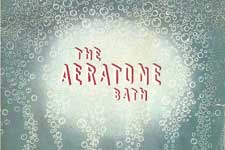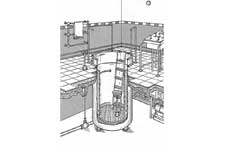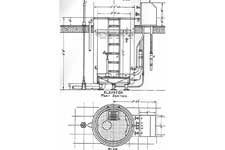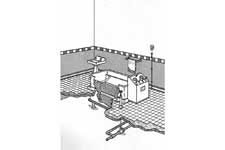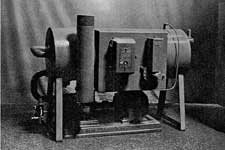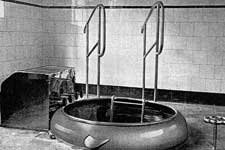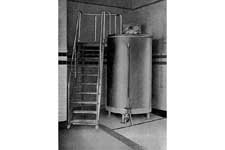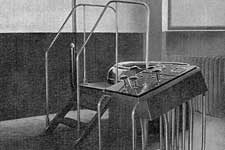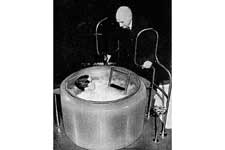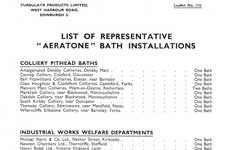Turbulayr Products Ltd
Contents
Outline history
Turbulayr Products Ltd was a Granton-based company, set up by Professor William Oliver, that made stainless steel products. They operated from about 1938 to 1953, and their best known product was the Aeratone bath. Some of these are still in use although the last one was made in the 1950s.
The company operated from premises that they described as West Harbour Road, but which the Edinburgh and Leith Post Office Directory described as Shore Road, Granton. The premises were located near the Northern Lighthouse Board depot.
Professor Oliver was an engineer and a part-time professor at the University of Edinburgh. Part of the funding for the company came from Sir Donald Pollock, also associated with the University of Edinburgh. They both lived near to Turbulayr’s premises.
Professor Oliver’s particular interest seems to have been equipment that was manufactured from stainless steel and used water and compressed air. He patented a number of items of this kind that he invented, some in conjunction with others, which included:
- Apparatus for washing or grading coal or similar or other granular material (1936)
- The Aeratone bath (1937)
- Fire Extinguishers (1941)
- Apparatus for the treatment of textile materials (1942)
- apparatus for dyeing, washing or bleaching yarn (1943)
The fire extinguisher was invented during World War II and was intended for dealing with incendiary bombs, even if no water supply was available.
The following link is to the US patent for the Turbulayr bath dated 1939.:
Steel has a long history, but mass production was not possible until the nineteenth century, after Henry Bessemer devised the ‘convertor’, patented in 1855. Steel consists of iron (symbol Fe) with smaller quantities of other elements, which make it stronger in tension – in other words when stretched or bent – than pure iron. But it is prone to rusting when it becomes wet. After many experiments, stainless steel was devised in the early part of the twentieth century. The date is often given as 1913. In addition to iron it contains Chromiuim (Cr) and other elements, which give it very much better resistance against rusting and attack by various chemicals.
The Aeratone bath
The bath consisted of a stainless steel cylinder 6 feet (1.8 metres) high and 3 feet 5 inches (just over 1 metre) in diameter. Inside was another slightly smaller stainless steel cylinder, which was perforated. Compressed air was blown into the bath between the two cylinders and aerated the water with small bubbles. The air supply was controlled by valves.
The recommendation was to have the water just above body temperature. Around the rim was a perforated tube which could give a refreshing spray of cold water from fine jets.
The preferred way to install the bath was to support it on a floor below the level that it was accessed from. The electric compressor and air reservoir that were required to operate the bath could also be installed on the lower level.
It was also possible to have the bath free-standing above floor level, with a ladder for users to enter it.
An alternative design was also available, for a horizontal bath.
The company produced an illustrated booklet which is available on our website in two versions:
Drawings
Compressor and air reservoir
Some installations
These views show some different arrangements, the first with the controls located so that the user could operate them and the third with controls for operation by an attendant.
In use
The following film clip shows an Aeratone bath in use.
Where were they installed?
Turbulayr Products Ltd classified their customers as follows:
- Colliery pithead baths
- Industrial works welfare departments
- Public baths
- Private clinics, public clinics, spas and hospitals
- Football clubs
Click the following image to see the company’s own list of some of the baths that were installed:
In the Edinburgh area, there was a bath – still there – at Portobello Baths (now Portobello Swim centre), installed in June 1939 and one at Warrender Baths.
Are there any still in use?
Aeratone baths are still in use at a number of locations, despite the last one having been made in the 1950s. Locally, this includes Portobello Swim Centre where an Aeratone bath was installed in June 1939. One that has received greater publicity recently was at Victoria Baths, Manchester. These baths had fallen into disrepair but are being restored with funding from English Heritage and the A6 Partnership. The Aeratone bath there was installed in 1952.
These links are to web pages with information about some Aeratone baths still in use:
What happened to the company?
Turbulayr Ltd seem to have gone out of business about 1954. Professor Oliver was then approaching seventy years of age and had retired from the University of Edinburgh in 1953.
A new product was launched about the same time in the USA, which worked on a different principle, using jets of water rather than compressed air to give a therapeutic effect. It was manufactured by the Jacuzzi![]() company, was promoted on TV, and became a well-known name.
company, was promoted on TV, and became a well-known name.
More information
For more information about the Aeratone bath, please have a look at the company's booklet. There is a choice of two ways to view the booklet. Please select one of the links below...
There is more information on other pages.
For more information about the people involved with the company, please click on the following links.
